
Phrymaceae, also known as the lopseed family, is a small family of flowering plants in the order Lamiales. It has a nearly cosmopolitan distribution, but is concentrated in two centers of diversity, one in Australia, the other in western North America. Members of this family occur in diverse habitats, including deserts, river banks and mountains.

Mimulus, also known as monkeyflowers, is a plant genus in the family Phrymaceae, which was traditionally placed in family Scrophulariaceae. The genus now contains only seven species, two native to eastern North America and the other five native to Asia, Australia, Africa, or Madagascar. In the past, about 150 species were placed in this genus, most of which have since been assigned to other genera, the majority to genus Erythranthe.
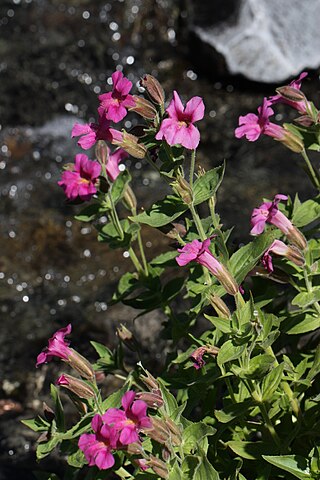
Erythranthe lewisii is a perennial plant in the family Phrymaceae. It is named in honor of explorer Meriwether Lewis. Together with other species in Erythranthe, it serves as a model system for studying pollinator-based reproductive isolation. It was formerly known as Mimulus lewisii.
Diplacus congdonii is a species of monkeyflower known by the common name Congdon's monkeyflower.
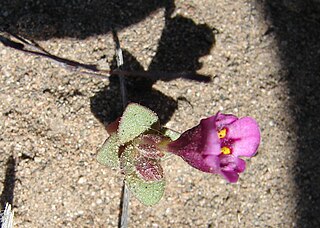
Diplacus cusickii is a species of monkeyflower known by the common name Cusick's monkeyflower. It is native to the western United States, where it can be found in parts of the Pacific Northwest and Great Basin. It grows in moist spots in bare and scrubby habitat, rocky slopes and plateau.
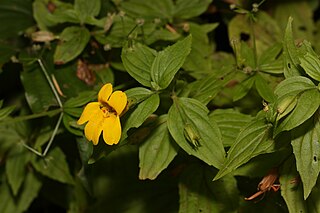
Erythranthe dentata is a species of monkeyflower known by the common names coastal monkeyflower and toothleaf monkeyflower. It is native to the western coast of North America from British Columbia to northern California, where it grows in moist habitat. It was formerly known as Mimulus dentatus.

Diplacus jepsonii, formerly classified as Mimulus nanus var. jepsonii, is a species of monkeyflower known by the common name Jepson's monkeyflower.
Diplacus johnstonii is a species of monkeyflower known by the common name Johnston's monkeyflower.
Erythranthe inflatula, synonyms Mimulus inflatulus and Mimulus evanescens, is a rare species of monkeyflower known by the common name disappearing monkeyflower. It is native to the western United States, where it is known from about ten locations in and around the Great Basin within the states of Idaho, Oregon, and California; it is also found in Nevada. Specimens of the plant had been catalogued as Mimulus breviflorus, but on further examination it was evident that they were a separate, unclassified species; this was described to science in 1995. It is thought that the plant may have evolved via hybridization between Erythranthe breviflora and Erythranthe latidens, or that it evolved from E. latidens and then into E. breviflora.
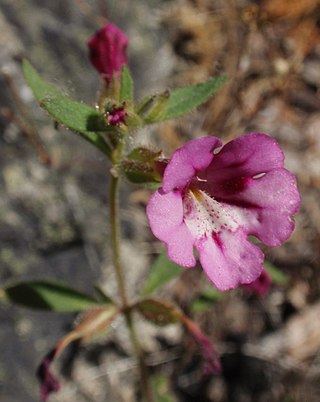
Diplacus layneae is a species of monkeyflower known by the common name Layne's monkeyflower. It is an annual herb that is endemic to California.
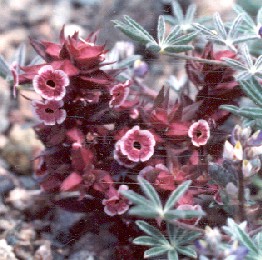
Diplacus mohavensis is a species of monkeyflower known by the common name Mojave monkeyflower.
Erythranthe montioides is a species of monkeyflower known by the common name montia-like monkeyflower. It is native to the Sierra Nevada and its foothills in California, and it has been observed in the mountains near Carson City, Nevada. It grows in moist areas in the mountains and disturbed, rocky soils. It was formerly known as Mimulus montioides.

Mimetanthe is a genus of flowering plants in the family Phrymaceae. It has only one species, Mimetanthe pilosa, synonym Mimulus pilosus, known by the common names false monkeyflower and downy mimetanthe. It is native to the western United States and Baja California, where it grows in moist and disturbed habitat types. This plant is different enough from other monkeyflowers that it is treated in its own monotypic genus, Mimetanthe, or it may be retained in Mimulus.

Erythranthe michiganensis is a rare species of flowering plant in the lopseed family, known by the common name Michigan monkeyflower. This species occurs only in the Grand Traverse and Mackinac Straits areas within the American state of Michigan. It is one of only three plant species that are endemic to Michigan, with the other two being Voss's Goldenrod and Packera insulae-regalis.

Erythranthe gemmipara is a rare species of flowering plant in the family Phrymaceae, known by the common name Rocky Mountain monkeyflower. It is endemic to Colorado in the United States, where there are eight known occurrences. It was formerly known as Mimulus gemmiparus.
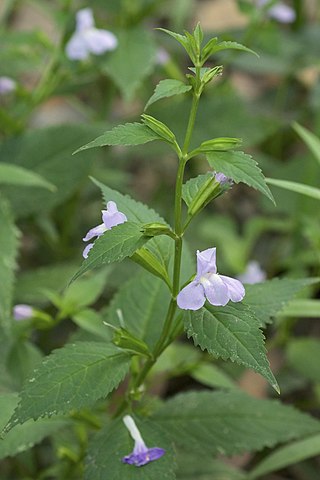
Mimulus alatus, the sharpwing monkeyflower, is an herbaceous eudicot perennial that has no floral scent. It is native to North America and its blooming season is from June to September. The flowering plant has green foliage and blue to violet flowers. It has a short life span compared to most other plants and a rapid growth rate. Like other monkey-flowers of the genus Mimulus, M. alatus grows best in wet to moist conditions and has a bilabiate corolla, meaning it is two-lipped. The arrangement of the upper and lower lip petals suggests a monkey’s face. The winged stems together with the monkey face give the plant its common name.

Erythranthe lutea is a species of monkeyflower also known as yellow monkeyflower, monkey musk, blotched monkey flowers, and blood-drop-emlets. It was formerly known as Mimulus luteus.

Erythranthe, the monkey-flowers and musk-flowers, is a diverse plant genus with more than 120 members in the family Phrymaceae. Erythranthe was originally described as a separate genus, then generally regarded as a section within the genus Mimulus, and recently returned to generic rank. Mimulus sect. Diplacus was segregated from Mimulus as a separate genus at the same time. Mimulus remains as a small genus of eastern North America and the Southern Hemisphere. Molecular data show Erythranthe and Diplacus to be distinct evolutionary lines that are distinct from Mimulus as strictly defined, although this nomenclature is controversial.

Diplacus is a plant genus in the family Phrymaceae, which was traditionally placed in family Scrophulariaceae. In the 2012 restructuring of Mimulus by Barker, et al., based largely upon DNA evidence, seven species were left in Mimulus, 111 placed into Erythranthe, 46 placed into Diplacus, two placed in Uvedalia, and one each placed in Elacholoma, Mimetanthe, and Thyridia. Diplacus used to be a separate genus from Mimulus, but it was merged into Mimulus no later than 1905, until the 2012 restructuring. Dry and rocky areas are preferred.

Erythranthe suksdorfii, with the common names Suksdorf's monkeyflower and miniature monkeyflower, is an annual flowering plant in the family Phrymaceae (Lopseed). It was formerly known as Mimulus suksdorfii. A specimen collected in Washington state in 1885 by the self-taught immigrant botanist Wilhelm Nikolaus Suksdorf was identified as a new species by Asa Gray in 1886, who named it in Suksdorf's honor. It can easily be misidentified with Erythranthe breviflora, which generally has elliptic leaves rather than the linear or oblong leaves found in E. suksdorfii.
















